What could be more emblematic of the summer-dry/winter wet, semi-arid, and arid climates of western North America than the wild buckwheats? Annuals, perennials, and low to medium or tall shrubs, one or more species of Eriogonum is native from western Canada to Baja California and throughout much of the intermountain west. More than 100 species are native to California, from seaside cliffs to rocky alpine outcrops.
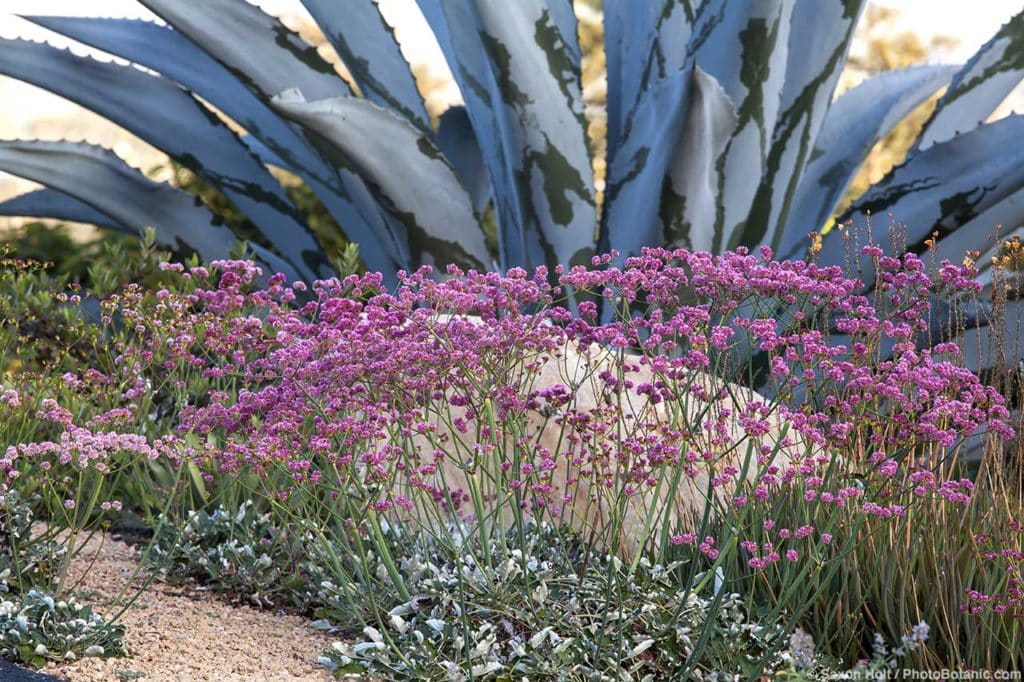
Eriogonum grande var. rubescens
Most of the buckwheats commonly available to gardeners are shrubs or shrubby perennials with green to gray-green or silvery gray leaves and masses of tiny flowers in small, tightly packed or loosely bundled heads borne either singly or in flat-topped or rounded clusters (umbels) in spring or summer. White, pink, near-red, or yellow flowers age to various shades of rusty orange to brown, giving plants a multicolored effect in late summer and fall. Buckwheat flowers are nectar sources for many insects, the seeds are loved by many small birds, and the leaves are larval food for butterflies.
Among low-mounding buckwheats, Eriogonum grande var. rubescens, red-flowered buckwheat, is about 1-2 feet tall and 2-4 feet wide with green to grayish green, oval leaves, white and woolly beneath, and clustered heads of tiny, rose-pink to purplish red flowers from midsummer well into fall. Native to the northern Channel Islands, this variety does best near the coast but seems fine inland with some afternoon shade.
Eriogonum latifolium, coast buckwheat, is similar but with leaves covered in white hairs and white to pale pink flowers in single rather than clustered heads. Native from the central California coast to coastal northern Oregon, this species does not seem as adaptable inland as red-flowered buckwheat but can be tried with part shade or afternoon shade and, if drainage is excellent, occasional summer water.
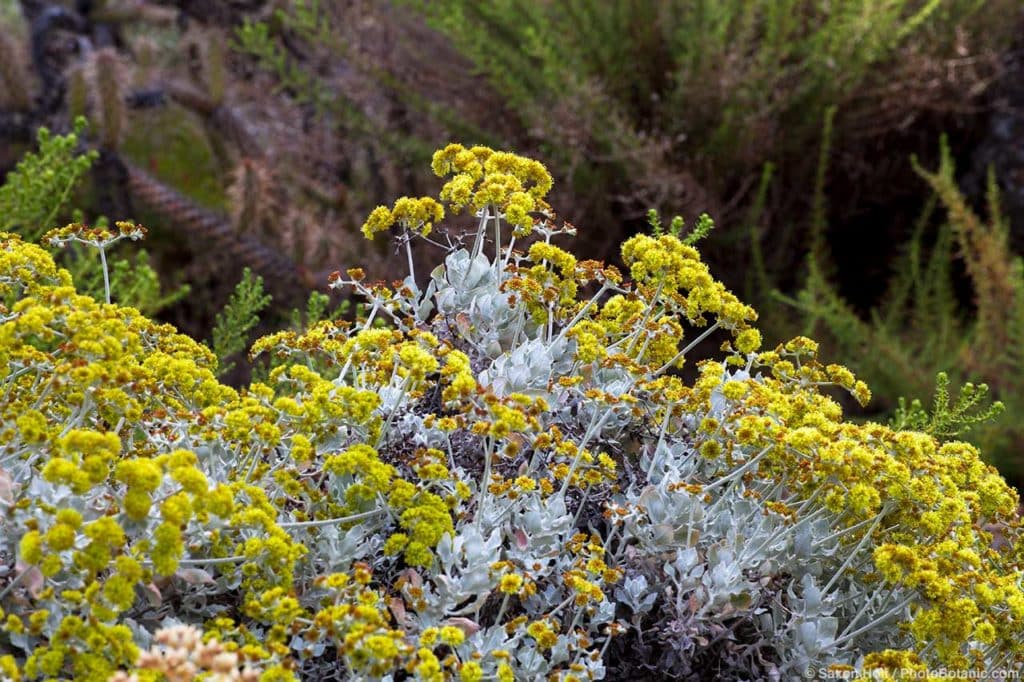
Eriogonum crocatum
Eriogonum crocatum, saffron buckwheat, is 1-2 feet tall and 2-3 feet wide, with gray-white, hairy leaves and stems and tightly packed heads of chartreuse yellow flowers in spring and summer. Native to dry, rocky hillsides in Ventura County, southern California, this species must have excellent drainage, but does just fine on steep clay slopes.
Several cultivars of the widespread and highly variable California buckwheat (Eriogonum fasciculatum) are low mounds to nearly flat mats. ‘Warriner Lytle’ and ‘Theodore Payne’ are less than 1 foot tall and spread 4-6 feet wide (sometimes 8-10 feet wide where especially content). ‘Dana Point’ is taller but still low mounding and can spread more than 10 feet wide. The species typically has small, almost needlelike leaves and creamy white to pink flowers in spring and summer. Varieties range from a few inches to six feet tall.
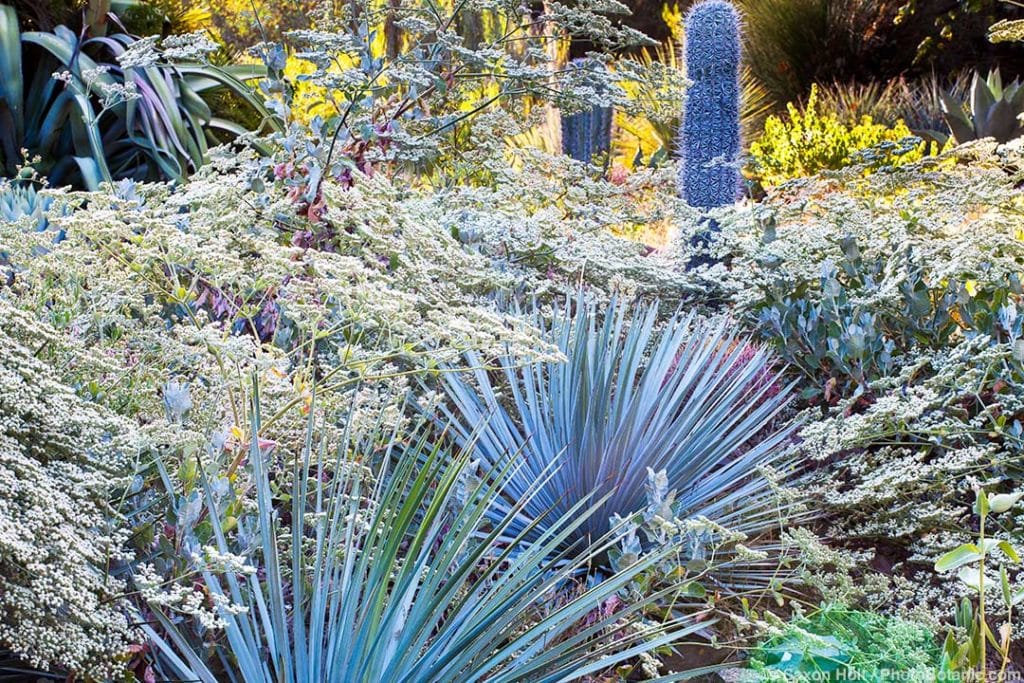
Eriogonum giganteum
Eriogonum umbellatum, sulfur buckwheat, is another highly variable species, with varieties ranging from perennials a few inches tall and 3 feet wide to shrubs six feet tall and wide. The paddle- or spoon shaped leaves are gray-green to green above, gray and woolly beneath, and the summer flowers are small, flat-topped or rounded clusters of yellow or creamy white. Selections in the nursery trade are most commonly about 1 foot tall and 2 feet wide with yellow flowers. The popular cultivar ‘Shasta Sulfur’, a selection of variety polyanthum, has silvery edged, spoon-shaped, green leaves and memorably bright yellow flowers. The selection of variety aureum trademarked Kannah Creek (‘Psdowns’) is a low mat, 1 foot tall and 1-2 feet wide with bright yellow flowers from late spring to midsummer that age to rusty orange. The leathery, green leaves of this western Colorado cultivar turn purplish red in winter.
Of the taller shrubs Eriogonum giganteum, St. Catherine’s lace, from Santa Catalina Island, is 4-10 feet tall and wide, with large, broadly oval, silvery gray-green, woolly leaves and flat-topped, open clusters of white flowers sometimes a foot in diameter. E. arborescens, Santa Cruz Island buckwheat, is native to coastal bluffs and grassy hillsides on several Channel Islands. Often a low mound but sometimes reaching 6 feet tall and wide, it has pale, gray-green leaves, whitish beneath, and creamy white or pale pink flowers, but is most distinctive for its attractively rough-textured mature bark.
A garden chock full of buckwheats is my ideal summer-dry garden. Here in near-coastal northern California, I am limited in the buckwheats I can grow because my resident deer seem to love them as much as I do. Those that survive with me are plants I have surrounded with prickly succulents, stinky alliums, or sages and other strong-smelling members of the mint family.
As a group, buckwheats seem to do best in coastal full sun, with some afternoon shade in hot inland climates, and good to excellent drainage. Along the coast they may need no summer water, but in hot inland valleys occasional water may be appreciated.


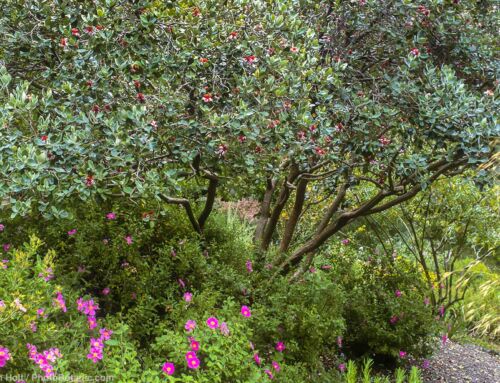
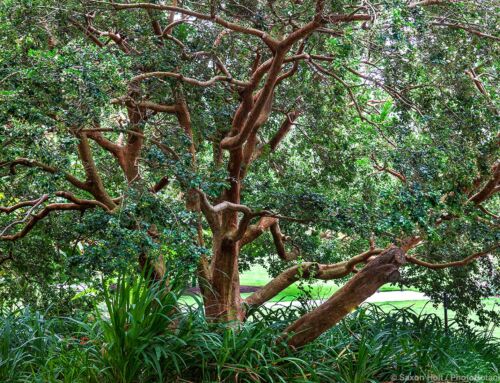
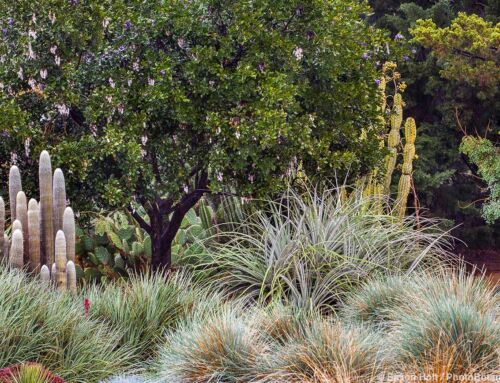
Leave A Comment